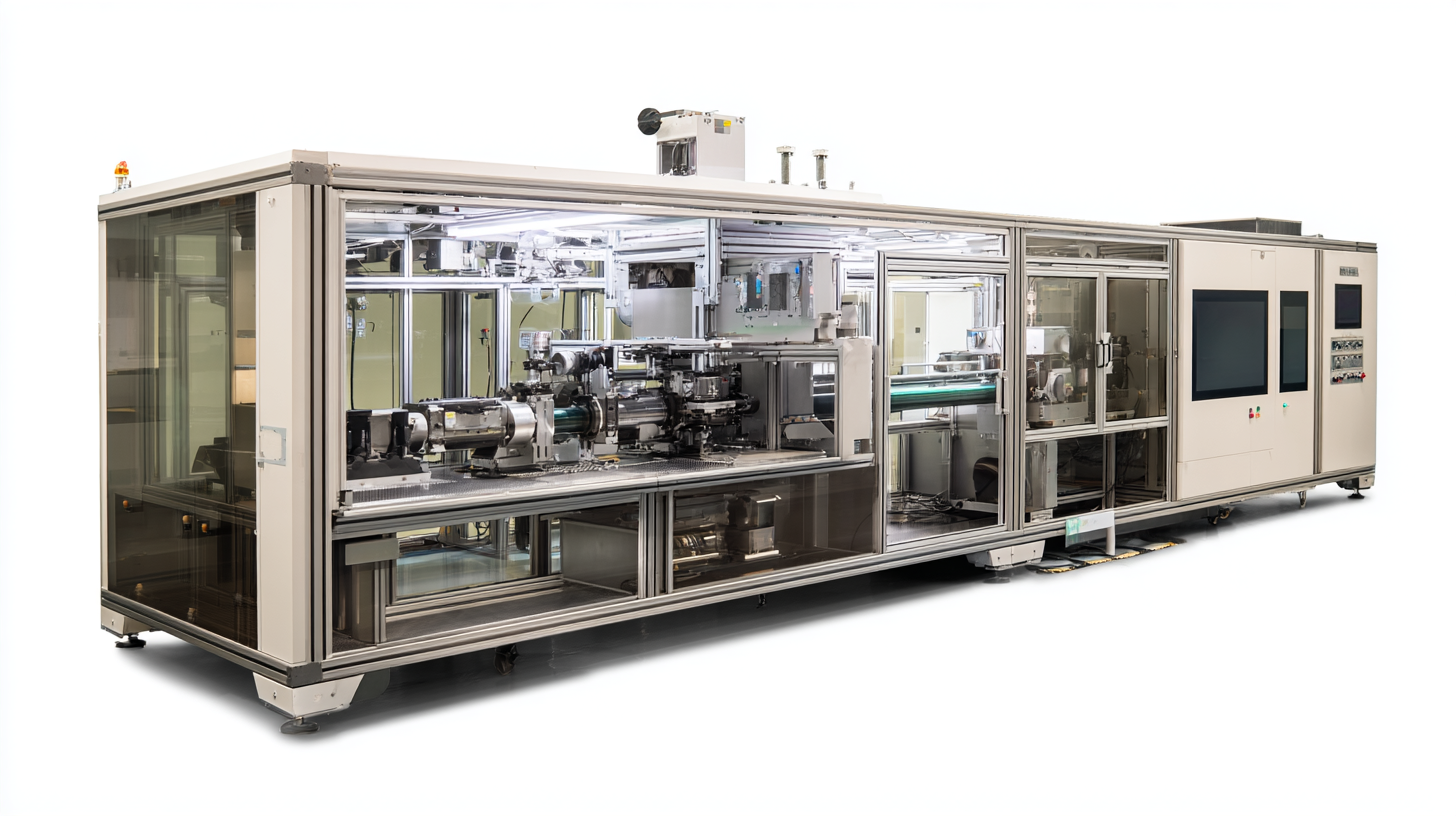The rapid advancement of thin film coating technology is transforming various industries by enhancing the performance and durability of products. According to a report by MarketsandMarkets, the global thin film coatings market is expected to reach USD 30.18 billion by 2025, growing at a CAGR of 6.9% from 2020 to 2025. This surge is driven by the increasing demand for high-performance coatings in sectors such as electronics, automotive, and solar energy. The integration of thin film coating machines into manufacturing processes allows for precise control over coating thickness and uniformity, resulting in improved functionality and aesthetics. With applications ranging from anti-reflective coatings for solar panels to scratch-resistant layers for smartphones, the role of thin film coating technology is pivotal in driving innovation and sustainability across industries. As businesses seek to enhance their operational efficiency and product lifespan, investing in advanced thin film coating machines emerges as a strategic imperative to stay competitive in a rapidly evolving marketplace.

The application of thin film coating technology is transforming industries by significantly enhancing performance across various manufacturing sectors. In semiconductor manufacturing, for instance, the use of atomic layer deposition (ALD) equipment enables the deposition of ultra-thin films with precise thickness control, crucial for the miniaturization of electronic components. Reports indicate that the ALD market is projected to grow substantially, driven by the increasing demand for advanced semiconductor devices and the integration of artificial intelligence into manufacturing processes.

In the photovoltaic realm, thin film coatings are essential for improving light absorption and efficiency in solar cells. Companies are increasingly adopting these technologies to enhance performance while reducing costs. The global thin film PV market is expected to witness robust growth as innovations make solar energy more viable and competitive. The integration of ion beam technology for efficient deposition and etching processes further expands its applications, showing promise in the production of high-frequency filters used in optical communication systems, ultimately contributing to the overall enhancement of telecommunications infrastructure.
Thin film coating technologies represent a transformative advancement across various industries, specifically for enhancing the durability and efficiency of products. According to a report by MarketsandMarkets, the global thin film coatings market is expected to reach USD 37.3 billion by 2025, driven by the demand for advanced materials in sectors such as electronics, automotive, and solar energy. These coatings provide superior resistance to wear, corrosion, and environmental degradation, making them ideal for components exposed to harsh conditions.
In the automotive industry, for instance, thin film coatings significantly improve performance and lifespan. Research indicates that vehicles utilizing enhanced coatings can achieve up to 20% improvement in fuel efficiency and a reduction in maintenance costs of around 30%. Similarly, in the semiconductor sector, thin film technologies are essential for the production of more efficient microchips, yielding a 15% increase in electrical performance while reducing production waste. These advancements not only bolster operational effectiveness but also contribute to a more sustainable approach in manufacturing processes.
| Industry | Thin Film Technology | Durability Improvement (%) | Efficiency Increase (%) | Application Example |
|---|---|---|---|---|
| Aerospace | PVD Coatings | 40 | 30 | Engine Components |
| Automotive | CVD Coatings | 35 | 25 | Transmission Parts |
| Electronics | Nano Coatings | 50 | 40 | Circuit Boards |
| Medical | Antimicrobial Coatings | 60 | 20 | Surgical Instruments |
 Thin film coating technology is making significant strides across various industries by enhancing product performance and extending longevity. One of the key sectors experiencing substantial benefits is the electronics industry. With the increasing demand for miniaturized and efficient devices, thin films are applied to create durable protective layers on components. This not only improves performance but also reduces energy consumption, ensuring more sustainable production practices.
Thin film coating technology is making significant strides across various industries by enhancing product performance and extending longevity. One of the key sectors experiencing substantial benefits is the electronics industry. With the increasing demand for miniaturized and efficient devices, thin films are applied to create durable protective layers on components. This not only improves performance but also reduces energy consumption, ensuring more sustainable production practices.
Another industry poised to gain from this technology is the automotive sector. Thin films are used on surfaces to improve scratch resistance and reduce friction in engine components, leading to enhanced fuel efficiency and vehicle lifespan. Additionally, the optical coating of windows and mirrors can provide better visibility and safety features.
Tip: When considering thin film coatings for your products, consult with industry experts to ensure you select the right materials that meet specific performance requirements. Also, evaluate different deposition techniques, as each may offer unique advantages depending on the application.
In the medical field, thin film coatings play a crucial role in improving the efficiency of medical devices and implants. These coatings can enhance biocompatibility and prevent biofouling, resulting in better patient outcomes and longer-lasting equipment.
Tip: Prioritize the selection of coatings that have been thoroughly tested for medical applications to ensure safety and effectiveness. Collaborating with knowledgeable partners in this area can guide you towards the best solutions.
The thin film coating technology is poised to revolutionize various industries by enhancing the performance of materials across a multitude of applications. A significant area of focus is the transparent conductive film market, where materials like Indium Tin Oxide (ITO), silver nanowires, and carbon nanotubes are leading the charge.
These materials are increasingly essential in consumer electronics, where the demand for high-efficiency touchscreens and solar cells continues to grow. The projected market size for transparent conductive films indicates strong growth, driven by advancements in manufacturing techniques and increasing applications in electronics.
Additionally, the corrosion-resistant coatings sector is gaining substantial traction as industries seek to protect their assets from environmental degradation. With types ranging from epoxy resin to polyurethane and acrylic coatings, the market is expected to see a sizable increase by 2031. The ongoing research into innovative coating materials and the development of eco-friendly alternatives position this sector for significant expansion. Trends such as sustainability and enhanced durability are forecasted to shape the future of coatings, ultimately allowing industries to achieve improved performance and longevity in their products.
The integration of thin film coating technology across various industries has proven to enhance product performance significantly. For instance, in the semiconductor sector, the global thin film deposition market is expected to reach USD 28.96 billion by 2025, driven by the increasing demand for miniaturization and high-performance electronic devices. Implementing thin film coatings can improve the durability and efficiency of components, as materials such as silicon and graphene are leveraged to create innovative surfaces that resist wear and corrosion.
In the aerospace industry, adopting thin film coatings can lead to weight reductions and increased fuel efficiency. According to a report by Research and Markets, the aerospace coatings market is projected to grow from USD 9.15 billion in 2020 to USD 12.34 billion by 2025. Practical tips for incorporating this technology include selecting the right coating materials that align with operational conditions, such as thermal and chemical resistance. Additionally, industry stakeholders should invest in advanced deposition techniques, like atomic layer deposition (ALD) or sputtering, to achieve optimal results. By focusing on these aspects, companies can effectively harness the benefits of thin film coating technology to revolutionize their processes and outputs.






